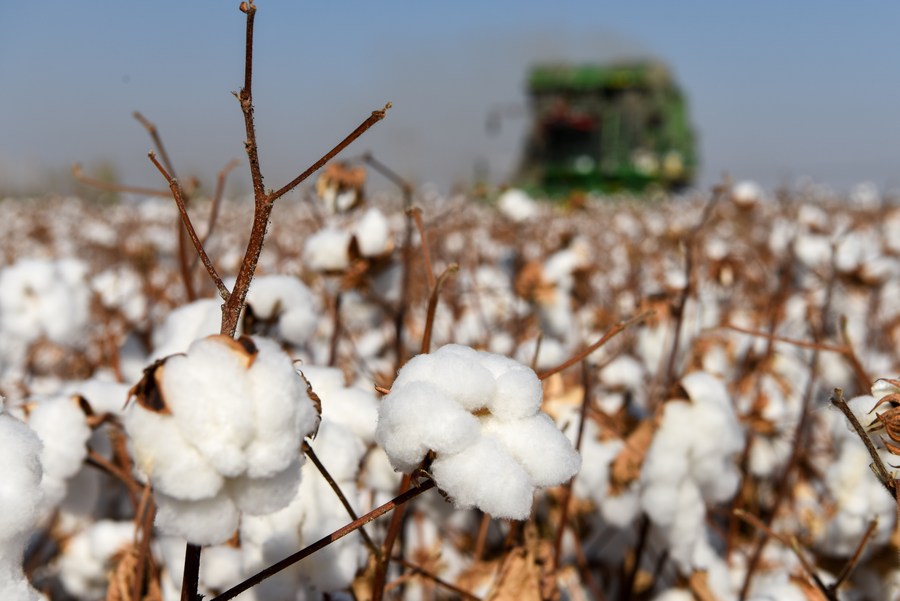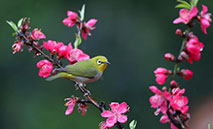Facts destroy lies, rumors about Xinjiang cotton
Chinese internet users have been angered after retail brands including H&M and Nike announced that they would prohibit the use of cotton produced in northwest China's Xinjiang Uygur Autonomous Region in the name of the "forced labor" and "discrimination against ethnic minorities" illusion.

A cotton harvesting machine works in a field in Manas County, Hui Autonomous Prefecture of Changji, northwest China's Xinjiang Uygur Autonomous Region, Oct. 17, 2020. (Xinhua/Ding Lei)
Facts speak louder than words. The following facts about Xinjiang's cotton will make the truth better known to the world.
Xinjiang produces world-class cotton thanks to its exceptional natural advantages. Large temperature differences between day and night in the summer and abundant sunshine make Xinjiang an ideal place to cultivate cotton. Xinjiang's long-staple cotton is the world's top variety and has been in short supply for many years.
The output of cotton per unit stood at 2,062.7 kilograms per hectare in 2020, up by 93.8 kilograms per hectare from the previous year, ranking first in the country, according to China's National Bureau of Statistics.
Xinjiang cotton barely meets China's own demand. China will see its cotton production in 2021 reach about 5.95 million tons, with a total demand of about 7.8 million tons and an annual shortfall of about 1.85 million tons.

Aerial photo taken on Oct. 17, 2020 shows a cotton harvesting machine working in a field in Manas County, Hui Autonomous Prefecture of Changji, northwest China's Xinjiang Uygur Autonomous Region. (Xinhua/Ding Lei)
The annual output of Xinjiang cotton is 5.2 million tons, accounting for about 87 percent of domestic production and about 67 percent of domestic consumption. The country has to import about 2 million tons of cotton every year to meet domestic demand.
Cotton production has become highly mechanized in Xinjiang. Even in the busy cotton harvesting season, there is no need for a large number of cotton pickers.
According to statistics released by Xinjiang's agricultural department, 69.83 percent of cotton in the region was harvested by machines in 2020, and the figure reached 95 percent in northern Xinjiang.
In fact, during the nearly 50-day cotton harvesting season in Xinjiang, cotton pickers can earn more than 10,000 yuan (about $1,530) on average. In recent years, the number of Han cotton pickers from places other than Xinjiang has decreased, mainly because these people have increased their incomes via other channels. The fact that fewer people are going to Xinjiang as cotton pickers means local people are not forced to work there.
Meanwhile, workers of all ethnic groups in Xinjiang choose their occupations according to their own wishes. They sign labor contracts with employers and earn salaries in accordance with China's Labor Law and other laws and regulations, and on the principle of equality and free will. They also enjoy freedom in choosing where they work.
The Chinese side has invited EU diplomatic envoys to China to visit the region many times, but they delayed the visits in every possible way for various reasons and even put forward unreasonable demands. To put it bluntly, they did not dare to face the real Xinjiang, fearing that the reality of a stable and prosperous Xinjiang, where people live and work in peace and contentment, would expose their lies.
Photos
Related Stories
- Commentary: Stop tainting Xinjiang's pure cotton with dirty politics
- China's Xinjiang denounces sanctions as utterly groundless
- Xinjiang regional government condemns sanctions announced by EU, U.S., Canada, UK: all lies and disinformation
- Unsettling intentions and suspicious origins: D.C.-based Newlines Institute has more skeletons in its anti-China closet
- Xinjiang accounts for 87% of China's cotton production
- Stories behind BCI ceasing sourcing cotton from China's Xinjiang over forced labor rumors
- Shared value of Western countries is to protect their privileged position: China Daily editorial
- China slams fabricated 'forced labor' lies on China's Xinjiang
- Spotless white Xinjiang cotton brooks no smearing: MOC
- Xinjiang officials, cotton farmers dismiss forced labor allegations
Copyright © 2021 People's Daily Online. All Rights Reserved.










